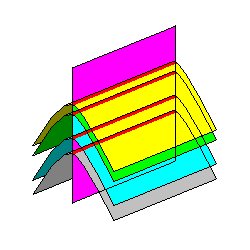Find a Fold Axis From the Intersection of Bedding and Foliation
Steven Dutch, Professor Emeritus, Natural and Applied Sciences, University of Wisconsin - Green Bay
 |
If we look at the axis of each individual layer in a fold, we get a series of lines in space that define a surface, the Axial Surface. If this surface is planar, as it often is approximately, we call it the Axial Plane. |
 |
The folding process often imparts a sheetlike grain, or foliation, to the rocks. The foliation is very often parallel to the axial plane of the fold. Compression on a large scale produces the fold, and compression on a small scale produces the foliation. |
 |
If the fold is cylindrical, the bedding at any point on the fold is parallel to the fold axis, and the foliation is parallel to the axial plane and therefore parallel to the fold axis. Then the intersection of bedding and foliation defines the fold axis. |
 |
The most common exception to axial-plane foliation is for the foliation to fan. However, fanning foliation usually is still parallel to the fold axis so the method of finding the fold axis from the intersection of bedding and foliation can still be applied. |
Example
 |
1. The problem. Given the strike and dip of bedding and foliation, what is the probable orientation of the fold axis? 2. Plot structure contours on bedding and foliation planes. 3. Determine the intersection of the two planes. 4. Find the trend and plunge of the intersection. This is the probable orientation of the fold axis. |
Comments
In this case the particular foliation plane itself has no significance, since foliation occurs all across the fold. We use the structure contours to find the fold axis, but otherwise we do not care about structure contours on the foliation plane. Thus you can choose any convenient location on the map to do this construction. That is what was done in Step 3 above.
In the vast majority of cases we would solve this problem on a stereonet. However, in a few cases it might be preferable to use a graphical approach. Stereonets typically give results accurate to within a couple of degrees for a single construction. If you intend to use the fold axis data to draw structure contours you might choose the graphical approach.
If you have a locality where the foliation is vertical (as it often is) and the strike of the bedding is perpendicular to it, the foliation defines the trend of the fold axis and the dip of the bedding defines the plunge. Do you see why? This can easily happen near the hinge of a fold.
Answer: the trend is the strike of a vertical plane containing the fold axis. If the foliation (which is parallel to the fold axis) is vertical, then its strike is also the trend. The intersection of bedding and foliation defines the fold axis, and if the bedding is perpendicular to the foliation then the intersection is down the dip of the bed.
Return to Course Syllabus
Return to Techniques Manual Index
Return to Professor Dutch's Home Page
Created 17 March 1999, Last Update